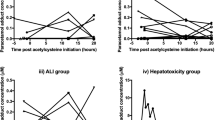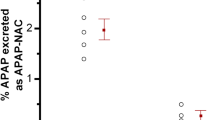Abstract
Purpose
Acetaminophen (APAP) protein adducts are a biomarker of APAP metabolism, reflecting oxidation of APAP and generation of the reactive metabolite N-acetyl-p-benzoquinone imine. High levels of adducts correspond to liver toxicity in patients with APAP-related acute liver failure. Adduct formation following low-dose exposure to APAP has not been well studied. APAP protein adducts were measured in blood samples collected from fasted individuals who participated in a crossover study of APAP (80 mg/kg) comparing extended release (ER) and immediate release (IR) formulations.
Methods
Adducts were quantified in all postdose blood samples using a validated high-performance liquid chromatography electrochemical detection (HPLC-EC) assay.
Results
Comparison of pharmacokinetic parameters for adducts did not reveal significant differences between ER and IR formulations, with one exception. Formation rates for adducts were faster for IR than the ER formulation (0.420 ± 0.157 vs. 0.203 ± 0.080 1/h), respectively. Maximum plasma concentrations (Cmax) of adducts for IR and ER were 0.108 (±0.020) and 0.100 (±0.028) nmol/ml serum, respectively, and were two orders of magnitude lower than adduct levels previously reported in adults with acute liver failure secondary to APAP.
Conclusions
APAP protein adducts are rapidly formed following nontoxic ingestion of APAP at levels significantly lower than those associated with acute liver failure.




Similar content being viewed by others
References
Larson AM, Polson J, Fontana RJ, Davern TJ, Lalani E, Hynan LS, Reisch JS, Schiodt FV, Ostapowicz G, Shakil AO, Lee WM (2005) Acetaminophen-induced acute liver failure: results of a United States multicenter, prospective study. Hepatology 42:1364–1372. doi:10.1002/hep.20948
Davern TJ 2nd, James LP, Hinson JA, Polson J, Larson AM, Fontana RJ, Lalani E, Munoz S, Shakil AO, Lee WM (2006) Measurement of serum acetaminophen-protein adducts in patients with acute liver failure. Gastroenterology 130:687–694. doi:10.1053/j.gastro.2006.01.033
James LP, Letzig L, Simpson PM, Capparelli E, Roberts DW, Hinson JA, Davern TJ, Lee WM (2009) Pharmacokinetics of acetaminophen-protein adducts in adults with acetaminophen overdose and acute liver failure. Drug Metab Dispos 37:1779–1784. doi:10.1124/dmd.108.026195
Schiodt FV, Ott P, Christensen E, Bondesen S (2002) The value of plasma acetaminophen half-life in antidote-treated acetaminophen overdosage. Clin Pharmacol Ther 71:221–225
James LP, Capparelli EV, Simpson PM, Letzig L, Roberts D, Hinson JA, Kearns GL, Blumer JL, Sullivan JE (2008) Acetaminophen-associated hepatic injury: evaluation of acetaminophen protein adducts in children and adolescents with acetaminophen overdose. Clin Pharmacol Ther 84:684–690
Muldrew KL, James LP, Coop L, McCullough SS, Hendrickson HP, Hinson JA, Mayeux PR (2002) Determination of acetaminophen-protein adducts in mouse liver and serum and human serum after hepatotoxic doses of acetaminophen using high- performance liquid chromatography with electrochemical detection. Drug Metab Dispos 30:446–451
Mitchell JR, Thorgeirsson SS, Potter WZ, Jollow DJ, Keiser H (1974) Acetaminophen-induced hepatic injury: protective role of glutathione in man and rationale for therapy. Clin Pharmacol Ther 16:676–684
Heard KJ, Green JL, James LP, Judge BS, Zolot L, Rhyee S, Dart RC (2012) Acetaminophen-cysteine adducts during therapeutic dosing and following overdose. BMC Gastroenterol 11:20
Chiew A, Day P, Salonikas C, Naidoo D, Graudins A, Thomas R (2010) The comparative pharmacokinetics of modified-release paracetamol and immediate-release paracetamol in a simulated overdose model. Emerg Med J Austral 22:548–555
Bernal W, Auzinger G, Dhawan A, Wendon J (2010) Acute liver failure Lancet 376:190–201
Khandelwal NJL, Sanders C, Larson AM, Lee WM, The Acute Liver Failure Study Group (2011) Unrecognized acetaminophen toxicity as a cause of ‘indeterminate’ acute liver failure. Hepatology 53:567–576
Mitchell JR, Jollow DJ, Potter WZ, Gillette JR, Brodie BB (1973) Acetaminophen-induced hepatic necrosis. IV. Protective role of glutathione. J Pharmacol Exp Ther 187:211–217
Roberts DW, Pumford NR, Potter DW, Benson RW, Hinson JA (1987) A sensitive immunochemical assay for acetaminophen-protein adducts. J Pharmacol Exp Ther 241:527–533
Roberts DW, Bucci TJ, Benson RW, Warbritton AR, McRae TA, Pumford NR, Hinson JA (1991) Immunohistochemical localization and quantification of the 3-(cystein-S-yl)-acetaminophen protein adduct in acetaminophen hepatotoxicity. Am J Pathol 138:359–371
Acknowledgments
This work was supported in part by a research grant from the National Institute for Diabetes and Digestive and Kidney Diseases (DK81406). Drs. James and Roberts have a pending patent application for a point-of-care test for the measurement of acetaminophen protein adducts. Dr. James also receives salary support from the UAMS Translational Research Institute (grant UL1TR000039) through the NIH National Center for Research Resources and National Center for Advancing Translational Sciences.
Author information
Authors and Affiliations
Corresponding author
Rights and permissions
About this article
Cite this article
James, L.P., Chiew, A., Abdel-Rahman, S.M. et al. Acetaminophen protein adduct formation following low-dose acetaminophen exposure: comparison of immediate-release vs extended-release formulations. Eur J Clin Pharmacol 69, 851–857 (2013). https://doi.org/10.1007/s00228-012-1410-7
Received:
Accepted:
Published:
Issue Date:
DOI: https://doi.org/10.1007/s00228-012-1410-7




